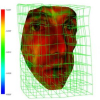Free Online Productivity Tools
i2Speak
i2Symbol
i2OCR
iTex2Img
iWeb2Print
iWeb2Shot
i2Type
iPdf2Split
iPdf2Merge
i2Bopomofo
i2Arabic
i2Style
i2Image
i2PDF
iLatex2Rtf
Sci2ools
ICPR
2006
IEEE
2006
IEEE
Uncertainties-driven Surface Morphing: The case of Photo-realistic Transitions between Facial Expressions
Reproduction of facial animation play a fundamental role in applications requiring human-computer interactions The objective of this paper is to introduce a geometric mechanism that exploits a fix number of states and is able to execute a subsequent number of transitions between facial expressions. Standard stereo-based techniques are used to reproduce the geometry and appearance of the most characteristic facial expressions. A novel free-form-deformation technique based on uncertainty driven local geometric registration in the space of distance transforms is used to produce a one-to-one mapping between the surfaces and the associated textures. Standard techniques from image morphing introduce the temporal aspect in the process. Experimental results and comparisons with actual observation demonstrate the potentials of such an approach.
Characteristic Facial Expressions | Computer Vision | Facial Animation | ICPR 2006 | Local Geometric Registration |
| Added | 09 Nov 2009 |
| Updated | 09 Nov 2009 |
| Type | Conference |
| Year | 2006 |
| Where | ICPR |
| Authors | Charlotte Ghys, Maxime Taron, Nikos Paragios |
Comments (0)

